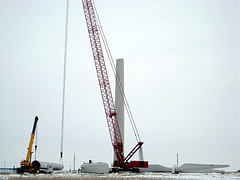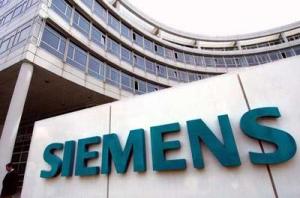Filed under: Wind | Tags: air spill, bp oil spill, cape wind, cape wind approved, huffington post, jim gordon, ken salazar, large ail reported at wind farm, offshore wind farm, oil spill, wind power
After months and months of deliberations, Interior Secretary Ken Salazar finally gave the federal go-ahead for Massachusetts developer Jim Gordon and his offshore windfarm project Cape Wind late last month. While a huge boon for wind-power advocates, the project still faces a series of challenging hurdles – not the least of which is clearing from the FAA, which still must determine whether the 130-turbine wind farm will interfere with air traffic control operations. Still, as a massive oil spill in the Gulf of Mexico continues to wreck havoc on the fragile environment and economy of that region, it seems like Salazar’s decision could not be better timed.

As a massive offshore oil drilling spill threatens the Gulf coast, the federal approval of the offshore wind farm project Cape Wind could not have been better timed.
As I’ve written previously, a couple friends of mine recently wrapped production on a years-long documentary of the fierce battle between Gordon’s supporters and detractors – the result, Cape Wind: The Fight for the Future of Power in America premieres soon and should be an exceptional inside look at a battle that has had national implications for America’s energy future. In light of Salazar’s exciting decision, and the incongruity of the implications of wind power and the drilling tragedy in the Gulf, I am sharing a headline from the Huffington Post I came across recently: “BREAKING: LARGE AIR SPILL AT WIND FARM. NO THREATS REPORTED. SOME CLAIM TO ENJOY THE BREEZE. ”
NYT’s Green Inc. reported today that German industrial heavyweight Siemens AG is moving aggressively into the North American wind market. Despite the light demand that currently exists for wind power in the U.S., Siemens seems eager to position itself for a potential upswing.
“The company expects the global wind energy market to be worth nearly $300 billion in 15 years, compared to a little over $40 billion today. Much of that growth, the company is betting, will be in North America, the company estimated.”
Unfortunately, this doesn’t necessarily translate into new American jobs, as the report notes. It cites an American University/ABC News report that broke the news last October that “more than 80 percent of the first $1 billion in grants [stimulus funds] to wind energy companies went to foreign firms.”
I looked through the report – thanks to Green Inc. for linking me to it – and it is pretty damning, i.e., some good journalism! It includes a quote from Senator Chuck Schumer, D-NY, that sums up my opinion on this quite well.
“Very few jobs here, lots of jobs in China. That is not what I intended or any other legislator who voted for the stimulus intended…It is fine that the Chinese make them. But why don’t we use the stimulus money to start building up an industry to build them here, that was the very point of the stimulus,” Schumer told ABC.
Filed under: Wind | Tags: american jobs, jobs, renewables, Wind, wind power
One of the focal points of this blog is examining the political promises of job creation through a new energy economy. Personally, I believe this is achievable, and I hope that political showboating doesn’t get in the way of a establishing a real revolution, both for sustainable energy and the American worker. Unfortunately, as this Seattle Times article suggests, there is always one problem: demand must exist for these energy solutions if there are to be jobs to create them.
 Despite building more wind power than ever before in 2009 – enough to power 2.4 million homes, according to the Seattle Times – many wind farms report they are slowing or stopping production altogether because of light demand. Even wind-turbine heavyweight Vestas, a Danish maker, has stopped production at its first U.S. plant, opened in 2008. Other firms report they would like to take advantage of the tax credits offered as part of last year’s federal stimulus, but must wait until credit markets loosen and demand for wind power increases.
Despite building more wind power than ever before in 2009 – enough to power 2.4 million homes, according to the Seattle Times – many wind farms report they are slowing or stopping production altogether because of light demand. Even wind-turbine heavyweight Vestas, a Danish maker, has stopped production at its first U.S. plant, opened in 2008. Other firms report they would like to take advantage of the tax credits offered as part of last year’s federal stimulus, but must wait until credit markets loosen and demand for wind power increases.
The article cites as one example Hexcel Corp, a Colorado-based manufacturer of wind turbine parts.
“Hexcel qualified for $8.1 million in tax credits, but it’s unlikely the company will complete more of its facility or take the rest of the credits this year. It might use them in 2011 or 2012, however, depending on demand, Bacal said. When fully operational, the plant will hire about 80 to 90 people.” (emphasis mine)
We know that the limp economy does not make for the best conditions to kickstart new energy projects. Yet, the wind industry also claims that until the Obama administration forms a clear, reliable plan for mainstream incorporation of renewable energies, investors will continue to hesitate on wind.
These sorts of projects need years of planning and support – if the Obama administration is serious about renewable energy – and the president’s recent forays into nuclear and clean coal suggests he may not be – then incentives for investors and users – not just producers – must be created now.
Lastly, training and investment in human capital must also increase. Almost half of all wind turbines installed in the U.S. last year were made overseas. Competitive advantage must be established in some capacity here in America if the president is serious about getting Americans back to work building energy infrastructure. Otherwise, we will continue to lose growth opportunities overseas to countries that have already long made these human and technological investments.
–Mia Lamar

